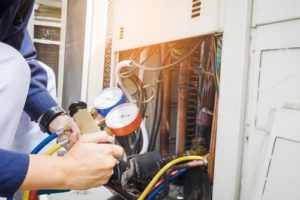You need your furnace to keep you warm when the weather outside is cold, so it’s important that you know how to fix it when something goes wrong. Furnaces are as complex and sensitive as air conditioners, which means that there is no end to things that can go wrong with them. Some of these problems can require professional help, while others can be fixed on their own if you have a little bit of knowledge and a few basic tools at your disposal. For those of you who are new to the idea of tinkering around with your furnace, behold: our furnace troubleshooting guide for beginners. By the time you’ve finished the following paragraphs, you should be able to prevent, diagnose, and solve simple furnace problems without wasting time or stressing yourself out too badly.
General Maintenance Tips: The Furnace Troubleshooting Basics
 HVAC systems can last for over a decade with proper care and maintenance, but it takes an owner who is willing to pay attention to the little things and put in a little elbow grease. Here are some of the simplest (but most important things) you can do to keep your furnace running predictably and efficiently.
HVAC systems can last for over a decade with proper care and maintenance, but it takes an owner who is willing to pay attention to the little things and put in a little elbow grease. Here are some of the simplest (but most important things) you can do to keep your furnace running predictably and efficiently.
- Change your filters: air filters can be responsible for numerous problems in both your furnace and your air conditioner, so take care to keep yours clean or replace them on a regular basis (depending on whether your HVAC uses single-use filters or reusable electrostatic ones). Fresh filters ensure that your furnace will not suffer from obstructed airflow and will help prevent dirt or dust from settling on your pilot light so that your furnace can always start up properly. Filters should be cleaned or replaced once every month for best results.
- Vacuum the area around the blower: another way to prevent debris from interfering with the way your furnace functions is to vacuum out the area around your blower motor on a yearly basis. Doing so can help protect your fan and blower motor from airborne debris that might make its way onto them even if your filters are in good condition.
- Clean the fan blades: once you have finished vacuuming, slide out the fan unit and clean each blade of your blower fan. One of the best ways to do this is by using an old toothbrush, or with the brush attachment that comes with most vacuum cleaners.
- Add oil to the blower motor: many blower motors have oil ports, which should be topped up once a year to ensure that the motor runs smoothly. Two or three drops of oil in each port should do the trick but remember to use non-detergent oil since detergent can cause problems for the motor while it is running and create a bigger problem than it solves.
How to Identify (and Solve) Common Furnace Problems
Now that you have a basic understanding of how to care for your furnace, you should know what to do if (and when) trouble manages to occur anyway. The fact is that a furnace problem or two is practically inevitable at some point during the lifespan of your HVAC. However, you can deal with several of the most common issues if you know how to recognize them.
- Leaking Gas: gas leaks are extremely serious and should never be left unchecked. If you smell natural gas in your home, immediately notify everyone in your home and make sure nobody ignites an open flame. Then, turn off your gas valve, evacuate the building and call your utility company.
- Faulty Pilot Light: the pilot light is responsible for igniting the fuel your furnace burns, so a broken or unreliable one is definitely a problem. Most of the time, a pilot light only stops working because it is old or dirty. Don’t try to clean a dirty pilot light yourself—call a professional for help. If your pilot light is just old and worn out, you’ll have to buy a new one.
- Not Enough Heat or Short-Cycling: these two problems occur when debris blocks the airflow in your system. Normally, blocked ducts only happen when filters are neglected, or the owner has not had the ducts cleaned in over five years. Prevent these problems by maintaining your filters diligently and arranging for professional duct cleaning every two to five years.
Furnace Troubleshooting Doesn’t Have to be Hard
Some basic knowledge is all it takes to make furnace troubleshooting easy and effective. Use the tips above to start out, and call for a licensed contractor if you need help. With luck, you should be able to keep your furnace running properly for many years to come.
Check with us here at Valley Comfort Heating and Air, our customers love our attention to detail and our friendly, affordable service. (707) 539-4533
